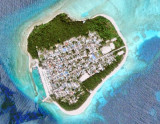
Ihavandiffulu Atoll est l'atoll N des îles Maldives.
Il est séparé en deux zones administratives: Alifu N et Alifu S.
L'atoll d'Ari, l'un des plus vastes des Maldives avec ses 80km de long et 30km de large est séparé en deux zones administratives: Alifu N et Alifu S.
Ari N comprend également les deux petits atolls de Rasdhoo (9 km de diamètre) et de Thoddoo. Il a pour capitale l'île de Rasdhoo, alors qu'Ari S a pour capitale Mahibadhoo.Thodhoo est réputé à travers toutes les Maldives pour ses pastèques, mais également pour les découvertes archéologiques qui y ont été faites en 1958, lesquelles révélèrent que l'île était un important centre bouddhiste avant la conversion du pays à l'Islam. L'atoll comprend environ 70 îles dont 18 sont habitées et dont 25 sont consacrées au tourisme. La plupart de ces îles, dans l'atoll, sont grandes avec une végétation abondante et, ce qui n'est pas courant, elles sont toutes situées sur le versant extérieur de l'atoll.Dans la moitié E du lagon les profondeurs sont de 37 à 55m et de 18,3 à 37 m dans la moitié W du lagon. De nombreux hauts-fonds se trouvent dans le lagon et notamment dans la partie W. Ces hauts-fonds, lorsque le soleil se lève, peuvent être reconnus grâce à leur couleur vert pâle contrastant avec le ton foncé de l'eau plus profonde; ils ne sont pas facilement visibles si le ciel est couvert.La principale occupation est la pêche et la culture des noix de coco, la majorité des îles sont couvertes de palmiers.
Les courants sur l'atoll Ihavandiffulu sont probablement entièrement influencés par le temps local.
Un courant de 2 noeuds venant du N a été relevé en décembre, à environ 50 NM à l'E de l'atoll, mais pratiquement aucun courant dans cette zone, n'a été observé un mois plus tard.Pendant les mois de décembre et de janvier le courant vient du N ou de l'W, mais est irrégulier.Les navires qui approchent l'atoll par le N entrent par le North Rock Passage, entre Wagaru et North Rock, à 1 mile à l'W; par l'entrée Nord-Ouest, entre Wagaru et Turakana, ou par l'entrée Nord, entre Turakana et Ulegama.
North Rock Passage est profond d'au moins 18,3 m en longeant Wagaru; les autres entrées ont des profondeurs d'au moins 20,1 dans le milieu de parcours entre les îles, mais il ya des profondeurs plus faibles à proximité de la lagune dans l'entrée Nord. Les bords des récifs de chaque côté du passage peuvent être vu à une bonne distance.
Les navires qui approchent par l'E utilisent l'entrée Nord Est entre Ulegama et Murdu, à environ 1,8 miles au SE, ou à l'entrée Est entre Muladu et Gallandu.
L'entrée Nord-Est a une profondeur minimale de 35m à mi-chemin entre les îles.
Dans l'entrée Est, il ya un haut-fond à mi-chemin entre les îles et un second haut-fond plus loin au SSW. Si vous utilisez cette entrée, passer à l'extrémité NE de Medfuri en navigant au 287 ° et entrer dans le lagon. A l'extrémité S de Muladu prendre le 070 °, faire cap sur l'extrémité N de Hauwandu au 250 °, puis mouiller en face de cette île.
Attention.-Collingrufuri, Medufuri et Manafur, ces trois îles sont entourées par des têtes rocheuses, des eaux peu profondes, et se situent à environ 3,3 et 3 milesau N et 2.3 miles au NNE, respectivement, de Ihavandu. Deux rochers émergés se trouvent sur un haut-fond rocheux proches au N de Medufuri.
Un courant de NW entre Uleguma et Wagaru, et d'W entre Uleguma et Murdu, a été observé quelquefois. La vitesse maximum est d'environ 1 noeud. Au milieu du lagon il y a occasionnellement un courant de NW.
Endeavour Shoal, un haut-fond de corail avec une profondeur minimale de 6,1 m, se trouve à environ 3,3 miles au SSW de Uleguma.
Ormonde Rock, avec une profondeur minimale de 4,6 m, se trouve à environ 2 miles au SW de Ulegama.
En outre, il y a nombreux bancs rocheux dans le lagon, en particulier vers le NW et SW; dans des conditions appropriées tout peut être facilement vu depuis la mâture.
2011/11/3
Update
JB Antibes







 Ihavandiffulu Atoll is the N atoll of the Maldive islands.
Ihavandiffulu Atoll is the N atoll of the Maldive islands. Ihavandiffulu Atoll est l'atoll N des îles Maldives.
Ihavandiffulu Atoll est l'atoll N des îles Maldives.






